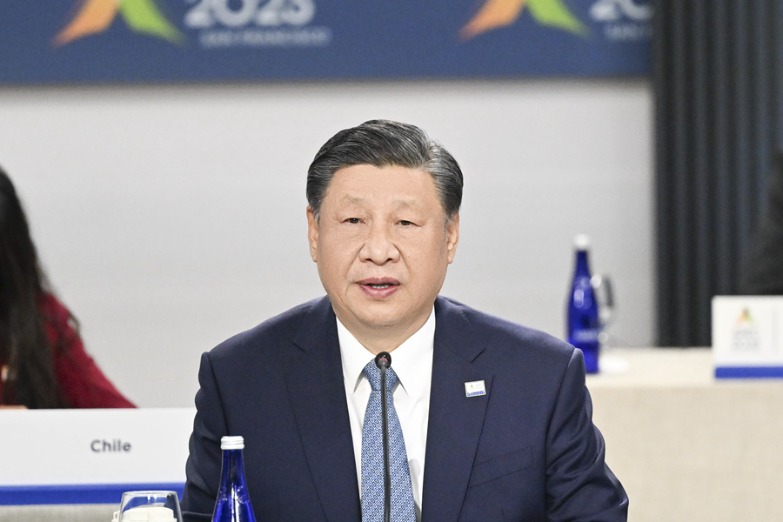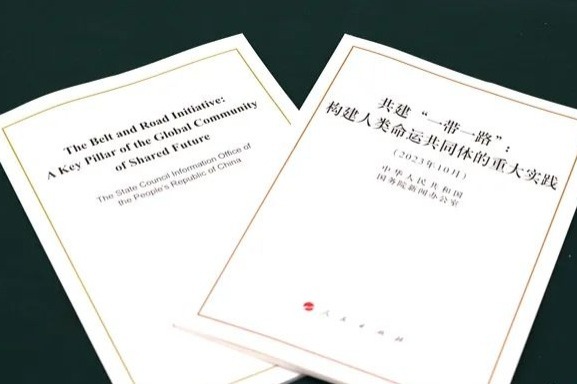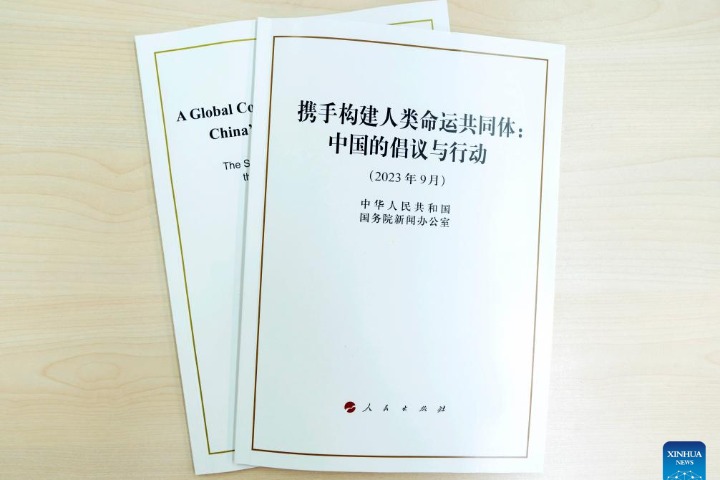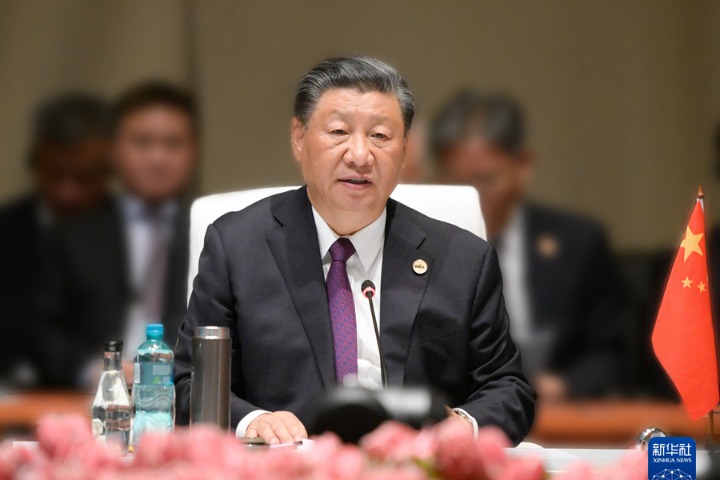《新疆的文化保护与发展》白皮书(双语全文)
新华网 2018-11-16 09:45

国务院新闻办公室15日发表《新疆的文化保护与发展》白皮书,全文如下:
新疆的文化保护与发展
Cultural Protection and Development in Xinjiang
中华人民共和国国务院新闻办公室
The State Council Information Office of the People’s Republic of China
2018年11月
November 2018
目录
Contents
前言
Preamble
一、新疆各民族文化是中华文化的组成部分
I.Xinjiang Ethnic Cultures Are Part of the Chinese Culture
二、各民族语言文字广泛使用
II.The Spoken and Written Languages of Ethnic Groups Are Widely Used
三、宗教文化受到尊重和保护
III.Respecting and Protecting Religious Culture
四、文化遗产保护和传承取得成就
IV.Protecting and Carrying Forward Cultural Heritage
五、文化事业和文化产业不断发展
V.Constant Development of Cultural Undertakings and the Cultural Industry
六、对外文化交流日趋活跃
VI.Active Cultural Exchanges with Other Countries
结束语
Conclusion
前言
Preamble
中国是统一的多民族国家。在5000多年文明发展史中,中华各民族共同创造了悠久历史、灿烂文化。新疆自古以来就是多民族迁徙聚居生活的地方,也是多种文化交流交融的舞台。在历史长河中,新疆各民族文化扎根中华文明沃土,既推动了各民族文化发展,也丰富了中华文化内涵。
China is a unified multi-ethnic country. In the course of a civilization that dates back more than 5,000 years, the various ethnic groups of China have created a long history and a splendid culture. Since ancient times many ethnic groups have made their way to Xinjiang, and it has become their home and a place for cultural integration. Various ethnic cultures of Xinjiang have their roots in the fertile soil of Chinese civilization, advancing their own cultural development while enriching the overall culture of China.
中华人民共和国成立后,中国政府高度重视新疆各民族优秀传统文化的挖掘、传承与保护,坚持创造性转化、创新性发展,鼓励各民族相互学习语言文字,促进各民族交往交流交融,尊重各民族宗教信仰自由,推动文化事业和文化产业发展,推进各民族文化现代化,加强对外文化交流,在不同文化交流互鉴中,增强文化自信。
Since the People's Republic of China was founded in 1949, the Chinese government has attached great importance to documenting and protecting the excellent traditional ethnic cultures in Xinjiang, and ensuring that they are passed on to succeeding generations. It has promoted creative transformation and innovative development, encouraging these ethnic groups to learn spoken and written languages from each other, promoted communication and integration, respected their freedom of religious belief, and worked to develop their cultural undertakings and industries. The government has worked to modernize ethnic cultures, to strengthen cultural exchanges with foreign countries, and to enhance each group's cultural confidence while engaging in exchanges with and mutual learning from others.
一、新疆各民族文化是中华文化的组成部分
I. Xinjiang Ethnic Cultures Are Part of the Chinese Culture
新疆历来是多民族聚居、多种文化并存地区。各民族文化长期交流交融,在中华文明沃土中枝繁叶茂,是中华文化的组成部分。
Since ancient times, Xinjiang has been home to various ethnic groups, where different ethnic cultures coexist. Through many years of communication and integration, these cultures thrive in the fertile soil of China's civilization and are part of the Chinese culture.
各民族文化是中华文化不可分割的一部分。自古以来,中华文化因环境多样性而呈现丰富多元形态。各民族文化在中华大地上交流交融,形成气象恢宏的中华文化。各民族文化都是中华民族共有精神财富,为中华文化的发展与进步做出了贡献。
Ethnic cultures make up an inseparable part of the Chinese culture. Since ancient times, China has been multicultural as a result of the diversity of its environment. Different ethnic cultures have communicated and integrated with each other, constituting a legacy shared by the Chinese nation that has brought into being a splendid Chinese culture.
早在先秦时期,新疆就与中原地区展开了密切交流,考古证实,新疆出土的彩陶就受到黄河中游地区仰韶文化的影响,在河南安阳的商代妇好墓中,陪葬了大量新疆和田玉制成的器物。西汉统一新疆地区后,汉语成为西域官府文书中的通用语之一。中原的农业生产技术、礼仪制度、汉文书籍、音乐舞蹈等在西域广泛传播。西域的乐器与音乐传入中原,对中原音乐产生重大影响。中华文化宝库中,就包括维吾尔族十二木卡姆艺术、哈萨克族阿依特斯艺术、柯尔克孜族史诗《玛纳斯》、蒙古族卫拉特史诗《江格尔》等各民族的优秀文化作品。
As early as in the pre-Qin period (c. 2100-221 BC), Xinjiang was in close contact with the Central Plains. Archaeological excavations demonstrate that painted potteryware unearthed in Xinjiang shows the influence of the Yangshao Culture in the middle reaches of the Yellow River, while many articles made from Xinjiang's Hetian jade were unearthed in the Shang-dynasty (c.1600 BC-1046 BC) Tomb of Fu Hao in Anyang, Henan in central China. After the Western Han (206 BC-AD 25) united Xinjiang, Chinese became one of the official languages used in government documents of the Western Regions where Xinjiang is located. Agricultural production techniques, the system of etiquette, Chinese-language books, music, and dances of the Central Plains spread widely in the Western Regions. Musical instruments and music from the Western Regions were introduced to the Central Plains and exerted a great influence on local music. The treasure house of Chinese culture boasts elements of the Uygur Muqam, the Kazak Aytes art, the Kirgiz epic Manas, the Jangar epic of the Oirat Mongols, and many other great cultural works of various ethnic groups.
新疆地区历来多种文化并存。中国的历史演进,决定了各民族在分布上交错杂居、经济上相互依存、文化上兼收并蓄的基本特征。新疆独特的自然地理环境造就了绿洲农耕与草原游牧文化的相得益彰,不同生产生活方式的族群交流互补、迁徙汇聚,开创了多种文化并存的生动局面。
Different cultures have long coexisted in Xinjiang. China's historical evolution has determined that various ethnic groups live together. They are economically interdependent and embrace each other's cultures. The unique natural environment and geographical conditions in Xinjiang resulted in the development of refined oasis farming and grassland nomadism, and migrating ethnic groups with different lifestyles and working practices communicated with, complemented and integrated with each other, creating a dynamic coexistence of different cultures.
新疆地区陆续发现大约20种语言文字。时至今日,汉藏语系、阿尔泰语系、印欧语系诸语言仍在新疆存在。生活中各民族语言兼用是新疆文化的传统特征。新疆各民族在交往交流交融中,不同语言的互借互用成为普遍现象。新疆克孜尔千佛洞、柏孜克里克石窟、北庭故城等融合了汉、回鹘、吐蕃以及新疆古代居民的多种文化元素,是古代中国文化艺术的典范。
Around 20 different spoken and written languages have been identified in Xinjiang. The Sino-Tibetan, Altaic, and Indo-European languages still exist in Xinjiang today, and a traditional feature of Xinjiang culture is that different languages are used in daily life. It was common for different ethnic groups to borrow from and use each other's languages. The Kizil Thousand-Buddha Caves, Bezkilik Grottoes, Beiting Ancient City Site, and some other Xinjiang sites that integrate multiple cultural factors from the Han, Huihu (an ancient name for modern Uygur), Tubo (an ancient name for modern Tibetan) and other ancient residents of Xinjiang are typical of the culture and art of ancient China.
历史上新疆是中华文明向西开放的门户和中介。丝绸之路的畅通开启了东西方文化交流交融的新篇章。丝绸之路繁盛时期,中国的造纸术、桑蚕丝织等先进技术通过新疆西传,对世界文明产生了深远影响。佛教、摩尼教、景教沿着丝绸之路传播到新疆,和当时的原始宗教一起在当地流传。在漫长的历史演进中,新疆多种宗教并存的情况从未发生改变。新疆的文化景观始终是多种文化并存、多元文化交流。
Historically Xinjiang was the gateway and medium through which the Chinese civilization opened to the West. The Silk Road opened a new chapter in cultural exchanges and integration between East and West. China's papermaking, sericulture, silk weaving, and other advanced technologies spread to the West via Xinjiang during the glory days of the Silk Road, exerting a far-reaching impact on world civilizations. Buddhism, Manichaeism and Nestorianism were introduced into Xinjiang through the Silk Road, and practiced together with primitive local religions. During Xinjiang's long historical evolution, it has always been a place where many religions have coexisted. The cultural landscape of Xinjiang has long been characterized by coexistence and communication between different cultures.
各民族文化长期交流交融。中华文化是凝聚各民族的精神纽带。在长期的生产生活中,各民族文化交流交融始终贯穿于中华文化形成、发展的全过程。受中原文化影响,新疆地区的蚕桑技术与丝绸织造取得了相当成就;最初形成于漠北时期的回鹘文化,深受我国北方游牧文化、中原文化以及佛教、摩尼教等影响。在各个历史发展阶段,各民族互学互鉴,涌现出一批政治家、文学家、艺术家、史学家、农学家、翻译家等,助推新疆各民族文化在中华文化怀抱中进一步发展。中华人民共和国成立后,在中国共产党领导下,新疆各民族文化进入新的繁荣发展时期,《我们的祖国是花园》《我们新疆好地方》等经典歌曲传唱大江南北;《冰山上的来客》《库尔班大叔上北京》等优秀电影在全国家喻户晓,成为各民族共同创造、共同享有的精神财富。
There is a long history of different ethnic cultures communicating and integrating with each other. The Chinese culture is a bond that unites various ethnic groups, while in the course of daily life and work, the communication between and integration of different ethnic cultures has helped to form and develop the Chinese culture. Influenced by the culture of the Central Plains, Xinjiang learned and rapidly developed sericulture and silk weaving. The Huihu culture that originated in the Mobei (the area north of the vast deserts on the Mongolian Plateau) regime was deeply influenced by the nomadic culture of northern China, Central Plains culture, Buddhism and Manichaeism. In different stages of history, various ethnic groups learned from each other, resulting in the emergence of a number of statesmen, writers, artists, historians, agronomists, and translators who made further contribution to the development of the ethnic cultures of Xinjiang in the embrace of the Chinese culture. After the People's Republic of China was founded in 1949, and under the leadership of the Communist Party of China (CPC), the ethnic cultures of Xinjiang entered a new period of prosperity and development. Our Motherland Is a Garden, Xinjiang, a Good Place and other classic songs are heard around the country; Visitors on the Icy Mountain, Uncle Kurban Visits Beijing and other quality films have become widely known. They are elements of a cultural wealth that has been created by and is shared by all ethnic groups.
新疆各民族成员共居、共学、共事、共乐,在语言、饮食、服饰、音乐、舞蹈、绘画、建筑等社会生活和文化艺术各方面相互影响、吸收融合,“你中有我,我中有你”始终是各民族文化的共同特点。
The ethnic groups of Xinjiang live together, study together, work together, and share happiness. They influence, assimilate and integrate with each other in language, diet, costume, music, dance, painting, architecture and other aspects of social life, culture and art. A common feature of these ethnic cultures is that all are interrelated.
二、各民族语言文字广泛使用
II. The Spoken and Written Languages of Ethnic Groups Are Widely Used
语言文字是文化的重要载体和鲜明标志。新疆是多语言、多文字地区,学习使用国家通用语言文字,是繁荣发展新疆各民族文化的历史经验。中国政府大力推广和规范使用国家通用语言文字,依法保障各民族使用和发展本民族语言文字的自由,提倡和鼓励各民族相互学习语言文字,不断促进各民族语言相通、心灵相通。
Language, in both spoken and written forms, is an important carrier and a distinct symbol of culture. Xinjiang is a multilingual region, and historical experience shows that learning and using the commonly used standard Chinese as a spoken and written language has helped develop Xinjiang's ethnic cultures. The Chinese government works hard to promote the use of the standard Chinese language, protects by law ethnic people's freedom to use and develop their own languages, and advocates and encourages ethnic groups to learn spoken and written languages from each other, so as to promote language communication and ethnic unity among all Chinese people.
依法推广国家通用语言文字。学习和使用国家通用语言文字,有利于促进各民族交往交流交融,推动各民族发展进步。1982年,“国家推广全国通用的普通话”写入《中华人民共和国宪法》。2001年1月1日《中华人民共和国国家通用语言文字法》正式施行,进一步明确了普通话和规范汉字作为国家通用语言文字的法定地位。2015年修订的《中华人民共和国教育法》规定“国家通用语言文字为学校及其他教育机构的基本教育教学语言文字”“民族自治地方以少数民族学生为主的学校及其他教育机构,从实际出发,使用国家通用语言文字和本民族或者当地民族通用的语言文字实施双语教育”。2015年修订的《新疆维吾尔自治区语言文字工作条例》规定“大力推广国家通用语言文字”。各民族成员为适应经济社会发展及交往日渐频繁的需要,积极主动学习和使用国家通用语言文字。
Promote standard Chinese by law. Learning and using standard Chinese helps different ethnic groups to communicate, develop and progress. When the Constitution of the People's Republic of China was revised in 1982, the sentence "The state promotes the nationwide use of Putonghua (common speech based on Beijing pronunciation)" was added. On January 1, 2001, the Law of the People's Republic of China on the Standard Spoken and Written Chinese Language took effect, clarifying the legitimate status of Putonghua and standardized Chinese characters as the standard Chinese language. The Educational Law of the People's Republic of China (Revised in 2015) provides: "The standard spoken and written Chinese language shall be the basic language used by schools and other educational institutions in education and teaching.... Schools and other educational institutions dominated by ethnic minority students in ethnic autonomous areas shall, according to the actual circumstances, use the standard spoken and written Chinese language and the spoken and written languages of their respective ethnicities or the spoken and written language commonly used by the local ethnicities to implement bilingual education." Regulations on the Work Concerning Spoken and Written Languages of Xinjiang Uygur Autonomous Region, revised in 2015, state the need to "promote the standard spoken and written Chinese language". Ethnic people are enthusiastic about learning and using standard Chinese to adapt to economic and social development and increased communication.
加强国家通用语言文字教育教学工作。响应国家号召,上世纪50年代开始,新疆在中小学对少数民族学生开设汉语文课程。1984年,新疆提出在少数民族学校加强汉语教学工作,实现“民汉兼通”的目标。目前,新疆在学前和中小学全面普及国家通用语言文字教学、加授本民族语言文字的双语教育,确保到2020年少数民族学生基本掌握和使用国家通用语言文字。
We should strengthen education and teaching of standard Chinese. In the 1950s, in response to the call of the state, Xinjiang began Chinese courses for ethnic minority students at elementary and secondary schools. In 1984, Xinjiang proposed to strengthen Chinese teaching at ethnic minority schools to achieve the goal that students "master both standard Chinese and their own ethnic languages". Currently, students at preschool institutions and elementary and secondary schools in Xinjiang have universal access to bilingual education, including teaching of standard Chinese and ethnic minority languages, ensuring that by 2020 all ethnic minority students will be able to master and use standard Chinese.
以多种形式开展国家通用语言文字培训工作。2013年启动“国家通用语言培训项目”,在少数民族人口集中的县(市)面向参加职业培训或创业培训的少数民族青年开展国家通用语言文字专项培训。2017年启动实施国家通用语言文字普及攻坚工程。
We should carry out various forms of training on the standard spoken and written Chinese language. In 2013, the "training program on the standard spoken and written Chinese language" was launched, a special program for ethnic minority youths participating in vocational or business training in counties or cities where people of ethnic minorities live in concentrated communities. In 2017, a program aimed to popularize standard Chinese by the year 2020 was launched.
科学保护各民族语言文字。《中华人民共和国宪法》和《中华人民共和国民族区域自治法》均明确规定,各民族都有使用和发展自己的语言文字的自由。目前,新疆各民族主要使用10种语言和文字,少数民族语言文字在司法、行政、教育、新闻出版、广播电视、互联网、社会公共事务等领域得到广泛使用。全国人民代表大会、中国人民政治协商会议召开的重要会议,提供维吾尔、哈萨克、蒙古等少数民族语言文字的文稿和同声传译。新疆本级和各自治州、自治县机关执行公务时,同时使用国家通用语言文字、实行区域自治的民族的语言文字。各民族成员有权使用本民族语言文字进行选举或诉讼。以少数民族学生为主的学校及其他教育机构,在课程设置和各类招生考试中均重视少数民族语言文字的学习和使用。每年一度的普通高等学校招生全国统一考试,新疆使用汉、维吾尔、哈萨克、柯尔克孜、蒙古5种文字试卷。
Protect spoken and written ethnic minority languages in a scientific way. The Constitution of the People's Republic of China and the Law on Regional Ethnic Autonomy both clearly prescribe that all ethnic groups have the freedom to use and develop their own spoken and written languages. Currently, 10 spoken and written languages are used among the various ethnic groups of Xinjiang. Ethnic minority languages are extensively used in such areas as judicature, administration, education, press and publishing, radio and television, internet, and public affairs. At important meetings such as those of the National People's Congress and the Chinese People's Political Consultative Conference documentation and simultaneous interpretation in Uygur, Kazak, Mongolian or other ethnic minority languages are provided. When performing official duties, Party and government organs of Xinjiang and lower-level autonomous prefectures and counties use at the same time standard Chinese and the languages of those ethnic minorities that exercise regional autonomy. All ethnic minorities have the right to use their own spoken and written languages in elections and judicial matters. Schools and other educational institutions where ethnic minority students are the majority highlight the study and use of ethnic minority languages in setting their curricula and in various entrance examinations. Xinjiang uses Chinese, Uygur, Kazak, Kirgiz and Mongolian languages for the annual national higher education entrance examination.
为保护中国丰富的语言资源,中国政府自2015年起组织实施中国语言资源保护工程,收集记录汉语方言、少数民族语言和口头语言文化的实态语料。该工程作为目前世界上规模最大的语言资源保护项目,已实现全国范围覆盖,其中在新疆开展包括30多个少数民族语言调查点、10个汉语方言调查点、6个濒危语言调查点和2个语言文化调查点的田野调查。截至目前,已完成新疆规划调查点超过80%的调查任务,并形成一批标志性成果。
In 2015 the Chinese government organized and launched a program to protect the rich language resources of China, collecting and recording physical forms of linguistic data such as Chinese dialects, spoken and written languages of ethnic minorities, and oral language cultures. The largest of its kind in the world, this program has covered the whole country. Field surveys have been conducted in Xinjiang, covering more than 30 survey locations of ethnic minority languages, 10 locations of Chinese dialects, six locations of endangered languages, and two locations of language cultures. To date more than 80 percent of survey tasks in these locations have been completed, and some symbolic successes have been achieved.
多语言、多文种的新闻出版和广播电视是新疆的一大特色。新疆使用汉、维吾尔、哈萨克、柯尔克孜、蒙古、锡伯6种语言文字出版报纸、图书、音像制品和电子出版物。新疆电视台有汉、维吾尔、哈萨克、柯尔克孜4种语言电视节目,新疆人民广播电台有汉、维吾尔、哈萨克、柯尔克孜、蒙古5种语言广播节目,《新疆日报》用汉、维吾尔、哈萨克、蒙古4种文字出版。
Multilingual press and publication and radio and television are a major feature of Xinjiang. Xinjiang publishes newspapers, books, audio and video products, and e-publications in six spoken and written languages - Chinese, Uygur, Kazak, Kirgiz, Mongolian and Xibe. Xinjiang TV broadcasts in Chinese, Uygur, Kazak, and Kirgiz. Xinjiang People's Broadcasting Station broadcasts in Chinese, Uygur, Kazak, Kirgiz, and Mongolian. Xinjiang Daily is printed in Chinese, Uygur, Kazak and Mongolian.
为使各民族成员共享信息化时代的成果,中国政府制定了蒙古、藏、维吾尔、哈萨克、柯尔克孜等文字编码字符集、键盘、字模的国家标准,研究开发出多种少数民族文字排版系统、智能语音翻译系统,支持少数民族语言文字网站和新兴传播载体有序发展,不断提升少数民族语言文字信息化处理和社会应用能力。新疆设立民族语言文字工作委员会和各级民族语言文字研究机构,负责各民族语言文字的科学研究,推动各民族语言文字的规范化、标准化、信息化。
To enable ethnic minorities to share the achievements of the information age, the Chinese government has set national specifications of coded character set, keyboard, and type matrix for Mongolian, Tibetan, Uygur, Kazak, Kirgiz, and some other languages. It has studied and developed different typesetting systems and intelligent voice translation systems for several written ethnic minority languages. The government supports the orderly development of websites and emerging media in spoken and written ethnic minority languages, and works to improve information processing and application capabilities in ethnic minority languages. Xinjiang has set up the Ethnic Language Work Committee and ethnic minority language research institutes at different levels, which are responsible for scientific research into ethnic minority languages, and which work to make them more standardized and apply them in IT.
鼓励各民族互相学习语言文字。中国政府鼓励民族自治地方各民族互相学习语言文字,既要求少数民族学习国家通用语言文字,也鼓励少数民族地区的汉族居民学习少数民族语言文字,尤其重视基层公务员、新录用公职人员、公共服务行业从业人员的双语学习,并提供学习条件。新疆专门开办了汉族干部学习少数民族语言培训班。上世纪50年代以来,国家在新疆高校开设中国少数民族语言文学(维吾尔语言、哈萨克语言方向)专业,这些专业的学生毕业后大多从事行政、教育、少数民族语言文字研究工作。多年来,新疆各民族相互学习语言文字蔚然成风,掌握双语、多语的人员越来越多,推动了各民族交往交流交融。
Encourage ethnic groups to learn spoken and written languages from each other. The Chinese government encourages different ethnic groups in ethnic autonomous areas to learn languages from each other, urging ethnic minorities to learn standard Chinese while encouraging Han residents to learn ethnic minority languages. It emphasizes that grassroots civil servants, newly recruited civil servants, and employees in the public service sector should know two or more languages and provides facilities for their learning. Xinjiang conducts special training courses for Han officials to learn ethnic minority languages. Since the 1950s, the state has offered majors in ethnic minority languages and literature (Uygur and Kazak) at colleges and universities in Xinjiang; most graduates of these majors work in the fields of administration, education, and research on ethnic minority languages. For many years, it has been a common practice that different ethnic groups of Xinjiang learn languages from each other. More and more people are becoming bilingual or multilingual, which promotes communication and integration among all the ethnic groups.

















 英语点津微信
英语点津微信 双语小程序
双语小程序